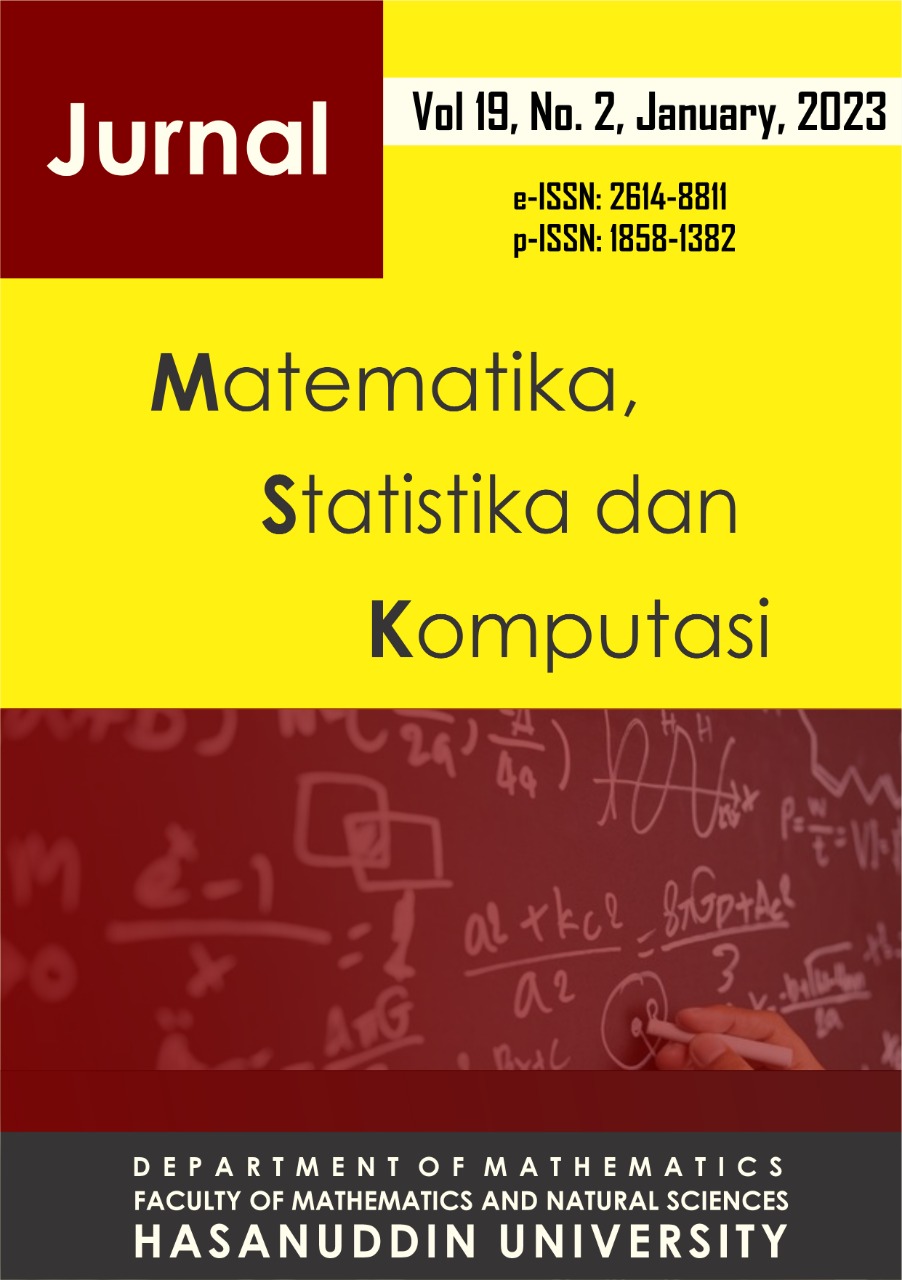Mathematical Model of COVID-19 with Quarantine and Vaccination
DOI:
https://doi.org/10.20956/j.v19i2.22301Keywords:
SEIR-VQ Model, Basic Reproduction Numbers, Next Generation MatrixAbstract
Abstract We present a mathematical model of COVID-19 disease by modifying the SEIR model. The model considers two additional compartments, quarantine (Q) and vaccination (V) which aim to control the spread of COVID-19. Based on the model, we obtained a disease-free equilibrium point and an endemic equilibrium point. The basic reproduction numbers were calculated using the next-generation matrix method. In this model, we analyzed the stability conditions that must be satisfied by the defining parameters. We perform data on the spread of COVID-19 in Indonesia for estimation to provide the parameter value in the model. Based on the result, there is an influence of changes in several parameter values on the number of individuals infected with COVID-19.Downloads
References
Aldila, D., Khoshnaw, S., Safitri, E., Anwar, Y., Bakry, A., Samiadji, B., Anugerah, D., Alfarizi, F., Dayanah Ayulani, I., & Salim, S., 2020. A mathematical study on the spread of COVID-19 considering social distancing and rapid assessment : The case of Jakarta, Indonesia. Chaos, Solitons & Fractals, 139, 110042.
Annas, S., Pratama, M., Rifandi, M., Sanusi, W., & Side, S., 2020. Stability Analysis and Numerical Simulation of SEIR Model for pandemic COVID-19 spread in Indonesia. Chaos, Solitons & Fractals, 139.
Attaullah, & Sohaib, M., 2020. Mathematical modeling and numerical simulation of HIV infection model. Results in Applied Mathematics, 7.
Cassels, S., Clark, S. J., & Morris, M., 2008. Mathematical Models for HIV Transmission Dynamics: Tools for Social and Behavioral Science Research NIH Public Access. J Acquir Immune Defic Syndr, 47(1), 34–39.
Chávez, J., Goetz, T., Siegmund, S., & Wijaya, K., 2017. An SIR-Dengue transmission model with seasonal effects and impulsive control. Mathematical Biosciences, 289.
Chitnis, N., Hyman, J., & Cushing, J., 2008. Determining Important Parameters in the Spread of Malaria Through the Sensitivity Analysis of a Mathematical Model. Bulletin of Mathematical Biology, 70, 1272–1296.
Hartati, H., Toaha, S., & Kasbawati, K., 2019. Stability analysis of SEISEIR-SEI modelling on the dynamics of spread dengue fever with vaccination and insecticide. Journal of Physics: Conference Series, 1341, 062033.
Iboi, E., Ngonghala, C., & Gumel, A., 2020. Will an imperfect vaccine curtail the COVID-19 pandemic in the U.S.? Infectious Disease Modelling, 5.
Mwalili, S., Kimathi, M., Ojiambo, V., Gathungu, D., & Mbogo, R. 2020. SEIR model for COVID-19 dynamics incorporating the environment and social distancing. BMC Research Notes, 13.
Ndairou, F., Area, I., Nieto, J., & Torres, D. F. M., 2020. Mathematical Modeling of COVID-19 Transmission Dynamics with a Case Study of Wuhan.
Nisardi, M. R., Kasbawati, K., Khaeruddin, K., Robinet, A., & Chetehouna, K., 2022. Fractional Mathematical Model of Covid-19 with Quarantine. InPrime: Indonesian Journal of Pure and Applied Mathematics, 4(1), 33–48.
Sulma, S., Toaha, S., & Kasbawati, K., 2020. Stability Analysis of Mathematical Models of the Dynamics of Spread of Meningitis with the Effects of Vaccination, Campaigns and Treatment. Jurnal Matematika, Statistika dan Komputasi, 17, 71–81.
Suriani, S., Toaha, S., & Kasbawati, K., 2020. MSEICR Fractional Order Mathematical Model of The Spread Hepatitis B. Jurnal Matematika, Statistika dan Komputasi, 17, 314–324.
[14] Zakary, O., Sara, B., Rachik, M., & Ferjouchia, H., 2020. Mathematical Model to Estimate and Predict the COVID-19 Infections in Morocco: Optimal Control Strategy. Journal of Applied Mathematics, 2020, 1–13.
Downloads
Published
How to Cite
Issue
Section
License
Copyright (c) 2023 Author and publisher

This work is licensed under a Creative Commons Attribution 4.0 International License.

This work is licensed under a Creative Commons Attribution 4.0 International License.
Jurnal Matematika, Statistika dan Komputasi is an Open Access journal, all articles are distributed under the terms of the Creative Commons Attribution License, allowing third parties to copy and redistribute the material in any medium or format, transform, and build upon the material, provided the original work is properly cited and states its license. This license allows authors and readers to use all articles, data sets, graphics and appendices in data mining applications, search engines, web sites, blogs and other platforms by providing appropriate reference.








